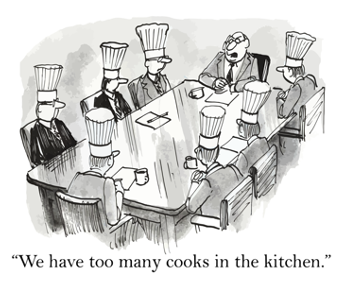Statisticians look for correlations between events, and according to the Hemline Index, skirt lengths are believed to fluctuate in tandem with the stock market. The theory proposes that during good economic times, hemlines rise, reflecting a more buoyant mood, while during economic downturns, hemlines fall, reflecting a more conservative and cautious approach to fashion. While only anecdotal, it seems to play out over history.
 One should not base investment decisions on fashion trends, as they may not have a direct causal connection to stock market movements. While interesting to observe, we must remember that correlation does not mean causation.
One should not base investment decisions on fashion trends, as they may not have a direct causal connection to stock market movements. While interesting to observe, we must remember that correlation does not mean causation.
Considering the ebb and flow of the emphasis on teamwork, a similar correlation could be hypothesized for the workplace. Each time there is a surge in the call for innovation or transformation, the focus turns towards the implication of teams. While there may not be a formally recognized index or theory like the Hemline Index for this correlation, it’s widely acknowledged that teamwork and collaboration are crucial for innovation; this is common sense. During periods of innovation, there often tends to be an increased emphasis on collaborative efforts and teamwork to foster creativity, problem-solving, and the generation of new ideas.
Teamwork = innovation and collaboration
The interplay between teamwork, innovation, and collaboration is complex. Organizational culture, leadership, and industry dynamics all influence the companies’ success with teamwork. While there may not be a direct quantifiable correlation like the Hemline Index, the value of teamwork in fostering innovation and collaboration is widely recognized and accepted in the business and academic communities.
 Teams have their time and place. Sometimes they work, sometimes they don’t. We can’t always impose that structure on an individual who doesn’t work well on a team. Sometimes, I’ve seen teamwork come up as the answer when group work would do. I have also seen rank-and-file employees working in teams be critical of executives who don’t work themselves as a team despite the leaders being vocal and passionate about teamwork. Still, each executive member remained focused on their numbers and individual division’s success.
Teams have their time and place. Sometimes they work, sometimes they don’t. We can’t always impose that structure on an individual who doesn’t work well on a team. Sometimes, I’ve seen teamwork come up as the answer when group work would do. I have also seen rank-and-file employees working in teams be critical of executives who don’t work themselves as a team despite the leaders being vocal and passionate about teamwork. Still, each executive member remained focused on their numbers and individual division’s success.
One client, an insurance company, was losing to the competition because their internal structure and processing could not quickly provide customers with complicated product policies. While the competition was turning around policy offers within days, this company took weeks. The company had a long, bureaucratic tradition of operating in distinct hierarchical silos. Each silo controlled a vital aspect of the policy-building process. Each worked at its own pace. As a result, internal barriers often take up to a month to meet customer needs.
To Team or Not To Team
Silo-busting made sense. But were teams the correct answer? The organization believed it could work, albeit with concerns that teamwork might contradict its values and culture, and it was trying to remain sensitive to the current culture of rewarding individual performance.
 Leadership formed 17 cross-functional teams, each aligning with an industry-specific customer industry sector. Every team went off-site, set its vision, clarified integrations of roles and responsibilities, and developed a motto and even a logo they printed on team sweatshirts. When they returned, they found a new work environment that placed each team in its own identifiable work area. With its business delivery process redefined, the team having clarified roles and responsibilities, and a mutual understanding of the purpose and measures for success, the organization waited on pins and needles to see how it would transpire.
Leadership formed 17 cross-functional teams, each aligning with an industry-specific customer industry sector. Every team went off-site, set its vision, clarified integrations of roles and responsibilities, and developed a motto and even a logo they printed on team sweatshirts. When they returned, they found a new work environment that placed each team in its own identifiable work area. With its business delivery process redefined, the team having clarified roles and responsibilities, and a mutual understanding of the purpose and measures for success, the organization waited on pins and needles to see how it would transpire.
The result is that 13 of the 17 teams performed well, achieving the desired results, significantly reducing customer service time and enhancing employee and customer satisfaction. Four teams failed miserably. Their team leaders were long-time executives and were the fundamental factors contributing to the team’s failure. The organization learned some valuable lessons. The journey emphasized the importance of awareness of values and behaviours before change. Defining the behaviours in advance enabled leaders to self-select whether they were comfortable and capable or not. The experience also suggested that sacrifices might be necessary. Since teams worked well throughout the organization, it was assumed they would work well at the top. The assumption proved wrong.
 At a second client, the executives simply didn’t mesh as a team. Was the group dysfunctional? No, the executive functioned better as a “working group.” Mandating them into a team, redesigning the established and working process of decision-making and negotiation, and imposing a set of team behaviours did not consider the reality of how they did their jobs. Plus, there was little interdependence. Teamwork here would have disrupted the leadership effectiveness.
At a second client, the executives simply didn’t mesh as a team. Was the group dysfunctional? No, the executive functioned better as a “working group.” Mandating them into a team, redesigning the established and working process of decision-making and negotiation, and imposing a set of team behaviours did not consider the reality of how they did their jobs. Plus, there was little interdependence. Teamwork here would have disrupted the leadership effectiveness.
Finally, a third organization had just engaged in a merger of near equals. Suddenly, team members from two different team-based organizations with distinctly different values and behaviours were thrown together in a giant boiling pot. Loyalties clashed, frustrations mounted, and business results were impeded.
For one of the organizations, individual contributions had always been a crucial success factor; however, this aspect was overlooked when teams were joined. The second organization focused on the importance of celebrating the success of the team along with the key individual contributor. The solution made inherent sense as it aligned with both cultures. The behaviour that emerged, if it had been part of the onboarding of the acquired firm, might have diminished some of the tensions between the two formerly rival companies.
Teams Overdone
The concept of teams can be overdone and excessively utilized. It does not fit all situations or all people. Sometimes, we throw the word around loosely when we mean something else entirely. We must challenge the prevailing assumption that teams always make things better and more efficient.
 Cracks appear when the form does not meet the function. When determining what form suits your organizational needs, consider the values and behaviours necessary for success before jumping onto the team bandwagon. High-performing organizations require a balance that fully exploits team, group, and individual approaches.
Cracks appear when the form does not meet the function. When determining what form suits your organizational needs, consider the values and behaviours necessary for success before jumping onto the team bandwagon. High-performing organizations require a balance that fully exploits team, group, and individual approaches.
What gets in the way of functioning teams:
- Clashes between the interests of the team and the individual members
- Leadership and the team’s interests do not align
- Individuals put their interests first
- Dependence on one team member to make an unequal contribution
- Uncertainty if the team’s goal contributes to the business’ success
- Members with more tenure at the company feel they have certain ‘rights.’
- Trying to be a team when a team is not required
Here are some ideas to consider when thinking about teams:
- Teams need a common purpose
- All team members must buy into the common purpose and act according to their assignment
- Teams must fit into the corporate values (culture) before implementation
- Teams need to know that some conflict is constructive while having agreed-upon behaviours to hold people accountable for non-constructive actions
- Teams can deliver better results than individuals
- Team results need precise measurements before the team starts as a team
- Teamwork in one organization doesn’t mean the same thing in another
- Like people, teams without positive consequences fear the worst
Teams can and will be around for a long time.
Please follow this link to a brief survey to assist in our research on what causes teams not to meet their performance expectations. I thank you in advance for your time and contribution.
Your turn
 Now is your turn to contribute your perspective on the discussion on LinkedIn
Now is your turn to contribute your perspective on the discussion on LinkedIn
 DS Cohen & Associates
DS Cohen & Associates
